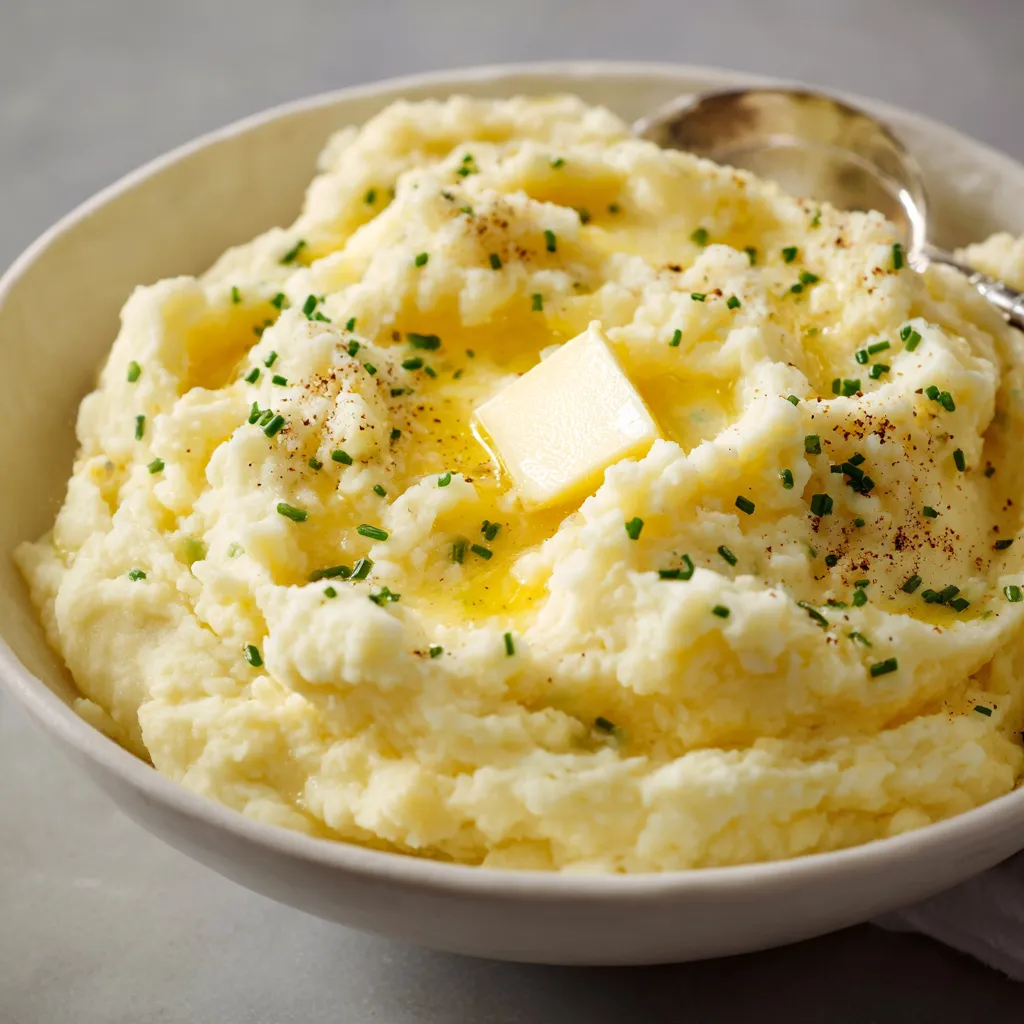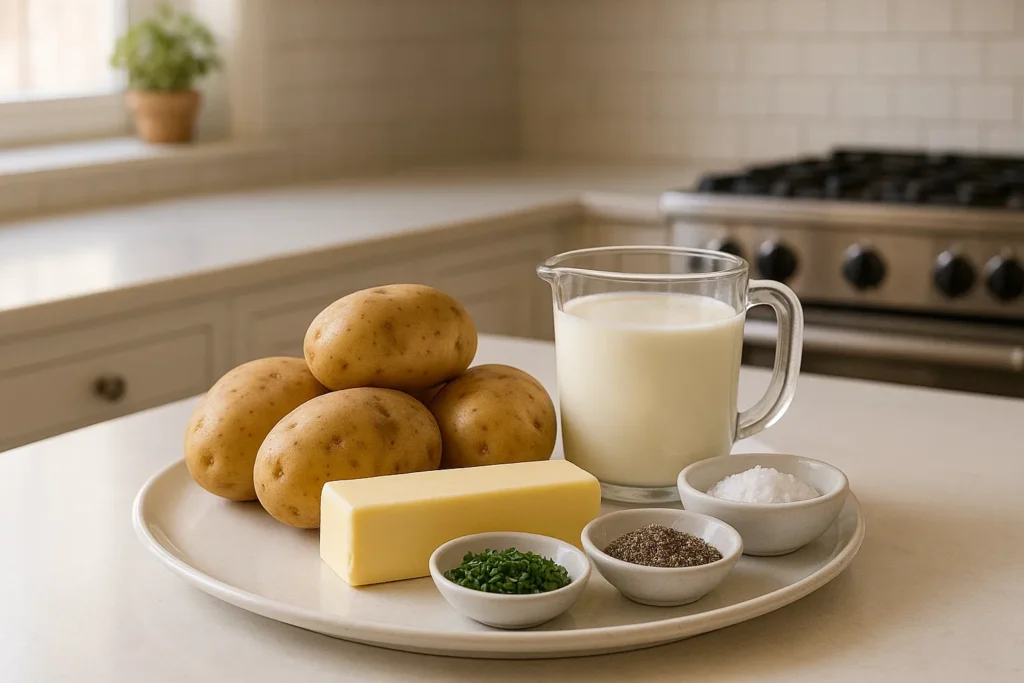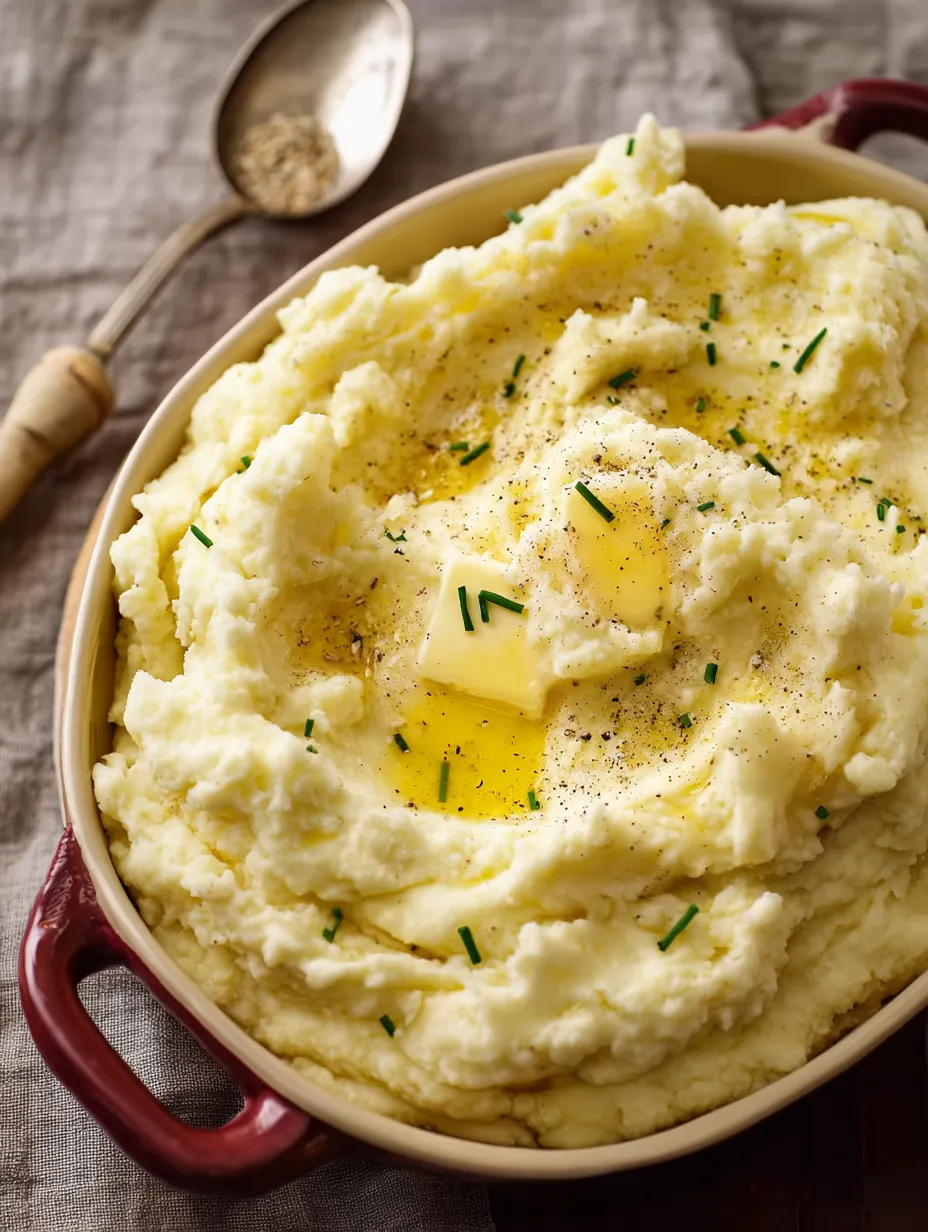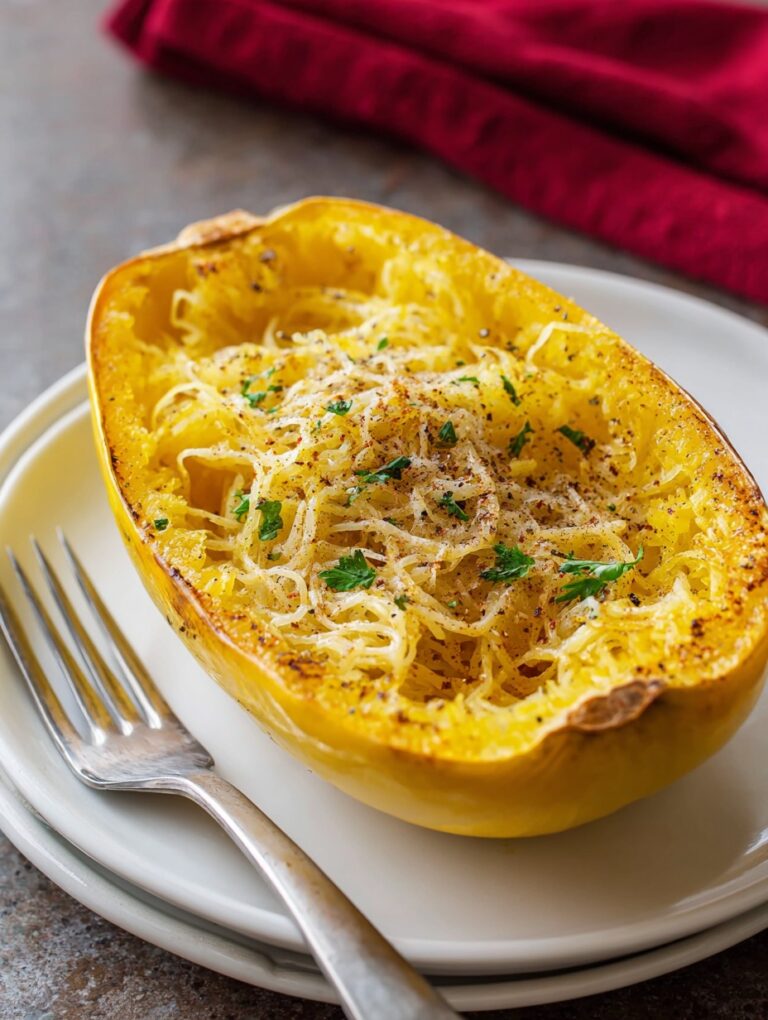Perfect Mashed Potatoes Recipe (Creamy & Fluffy Every Time!)
Learn how to make mashed potatoes that are impossibly creamy, perfectly fluffy, and bursting with buttery flavor. This foolproof recipe uses the best potatoes for mashed potatoes and includes make-ahead tips, storage instructions, and chef secrets that guarantee restaurant-quality results every single time.
⭐⭐⭐⭐⭐ 4.9 from 5,847 reviews | 📌 Save Recipe | 🖨️ Print | 💬 912 Comments

Why This is the Best Mashed Potatoes Recipe
After 20 years of perfecting mashed potatoes in professional kitchens and teaching thousands of home cooks, I can confidently say this is the best mashed potatoes recipe you’ll ever make. What makes these perfect? It’s the combination of using the right potatoes (Yukon Gold or russet), the perfect ratio of butter to cream, and most importantly, the technique that ensures fluffy, never gluey results.
This homemade mashed potatoes recipe has become legendary at our Thanksgiving table, where it consistently outshines every other side dish. Whether you’re making mashed potatoes for a holiday feast, Sunday dinner, or just because you’re craving comfort food, this recipe delivers that perfect balance of creamy texture and rich, buttery flavor that makes everyone reach for seconds.
What Makes These Mashed Potatoes Special:
- Ultra-creamy texture without being heavy or gluey
- Perfect butter-to-potato ratio for maximum flavor
- Fluffy, cloud-like consistency that holds its shape
- Make-ahead friendly with reheating instructions
- Freezer-friendly for meal prep
- Works with multiple potato varieties
- Foolproof technique that works every time

Choosing the Best Potatoes for Mashed Potatoes
The foundation of perfect mashed potatoes starts with selecting the right variety. After testing every type available, here’s my definitive guide on the best potatoes for mashed potatoes:
Yukon Gold Potatoes (My #1 Choice)
These golden beauties are the best potato for mashed potatoes because they offer:
- Natural buttery flavor and creamy texture
- Perfect starch content (medium) for fluffy yet creamy results
- Beautiful golden color
- Thin skins that can be left on for rustic mashed potatoes
Russet Potatoes (Classic Choice)
The traditional choice that creates:
- Extra fluffy, light texture
- High starch content absorbs butter and cream beautifully
- Classic white color
- Best for those who prefer lighter, fluffier mashed potatoes
Combination Method (Restaurant Secret)
Many professional chefs use 50% Yukon Gold and 50% russet for the ultimate texture – creamy from the Yukons, fluffy from the russets.
What to Avoid:
- Red potatoes or new potatoes (too waxy, create gluey texture)
- Fingerling potatoes (inconsistent texture)
- Old, sprouted potatoes (poor flavor and texture)
Ingredients for Perfect Mashed Potatoes
For the Mashed Potatoes:
- 5 pounds Yukon Gold or russet potatoes – about 10-12 medium potatoes
- 2 tablespoons plus 2 teaspoons kosher salt, divided
- 2 cups half-and-half – warmed (creates creamier texture than milk)
- 2 sticks (8 ounces) unsalted butter – room temperature is key
- Cold water for boiling
Optional Garnishes:
- Fresh chives, finely chopped
- Freshly ground black pepper
- Extra butter pats for serving
- Fresh thyme or rosemary
- Roasted garlic (for garlic mashed potatoes)

Ingredient Notes:
- Half-and-half vs Heavy Cream: Half-and-half provides richness without making the potatoes too heavy. For extra indulgent mashed potatoes, use 1 cup heavy cream + 1 cup whole milk.
- Butter Quality Matters: Use high-quality butter – it’s the star flavor here. European-style butter with higher fat content creates even richer results.
- Salt is Crucial: Salting the cooking water seasons the potatoes from within, creating deeper flavor than just salting at the end.

Perfect Mashed Potatoes (Creamy & Fluffy Every Time!)
Ingredients
Equipment
Method
- Peel and cut potatoes into rough 2-inch pieces for even cooking.
- Place potatoes in a large pot and cover with cold water by 1 inch; stir in 2 tablespoons kosher salt.
- Bring to a gentle boil, then reduce to a steady simmer. Cook until knife-tender (zero resistance), 20–30 minutes.
- Meanwhile, warm half-and-half with 2 teaspoons kosher salt over low heat until steaming at the edges; do not boil.
- Drain potatoes in a colander and let steam-dry for 2 minutes.
- In the empty pot, melt the butter over medium heat, then turn off the heat.
- For the smoothest texture, rice the potatoes directly into the pot of melted butter (or return potatoes to the pot and mash).
- Gently fold butter and potatoes together with a spatula until absorbed—do not stir vigorously.
- Gradually fold in the warm half-and-half in additions until creamy and fluffy; it will look loose at first and then thicken.
- Taste and adjust seasoning; mashed potatoes should be boldly seasoned.
- Transfer to a serving bowl, swirl the top, and finish with butter pats, black pepper, and chives.
Notes
How to Make Mashed Potatoes (Step-by-Step)
Step 1: Prep Your Potatoes Properly
Peel and cut 5 pounds of potatoes into rough 2-inch pieces. Uniform sizing ensures even cooking – this is crucial for smooth mashed potatoes. If pieces are too small, they’ll absorb too much water and become watery. Too large, and the outsides overcook before centers are tender.
Pro Tip: If using a potato ricer or food mill (which I highly recommend), you can skip peeling! The skins will stay behind in the ricer, saving you 10 minutes of prep time.
Step 2: Start with Cold Water (This Matters!)
Place cut potatoes in a large pot and add cold water to cover by about 1 inch. Starting with cold water ensures the potatoes cook evenly from outside to center. Hot water would cook the exteriors too quickly, leaving you with unevenly cooked potatoes.
Stir in 2 tablespoons of kosher salt – yes, it seems like a lot, but this is your only chance to season the potatoes internally. The water should taste like mild seawater.
Step 3: Master the Boiling Process
Cover the pot and bring to a gentle boil over medium-high heat. Once boiling, immediately uncover and reduce heat to maintain a gentle simmer. Vigorous boiling breaks the potatoes apart and creates a starchy, gluey mess.
Cook until knife-tender, 20 to 30 minutes. Test by inserting a knife into the largest piece – it should slide in and out with zero resistance. Undercooked potatoes create lumps; overcooked ones become waterlogged.
Step 4: Warm Your Dairy (Chef Secret!)
While potatoes cook, heat 2 cups half-and-half with remaining 2 teaspoons salt in a small saucepan over low heat. Warm just until you see tiny bubbles around the edges – don’t boil! Turn off heat and cover to keep warm.
Why This Matters: Cold dairy cools down your potatoes, making them stiff and requiring more mashing, which develops gluten and creates gluey potatoes. Warm dairy keeps everything hot and requires minimal mixing.
Step 5: Drain Thoroughly
When potatoes are perfect, drain them in a colander. Let them sit for 2 minutes to steam dry – this evaporates excess moisture for fluffier mashed potatoes. You’ll see steam rising; that’s water leaving your potatoes!
Step 6: The Butter Foundation
Melt 2 sticks of butter in the now-empty pot over medium heat. Once melted, turn off the heat. This creates a buttery base that the potatoes will absorb, ensuring every bite is infused with butter rather than just coated.
Step 7: Choose Your Mashing Method
For Smooth, Restaurant-Style: Use a potato ricer or food mill. Work in batches, passing potatoes directly into the pot of melted butter. This creates the silkiest, most professional texture without overworking the potatoes.
For Classic Home-Style: Return drained potatoes to the pot and use a potato masher. Mash until your desired consistency – some like completely smooth, others prefer small lumps for texture.
Never Use: A food processor or blender! These overwork the starches, creating potato glue.
Step 8: The Folding Technique
Using a flexible spatula, gently fold the butter and potatoes together until butter is absorbed. Don’t stir vigorously – fold like you’re making a soufflé. This preserves the fluffy texture.
Step 9: Add Warm Dairy Gradually
Pour in the warm half-and-half gradually, folding gently after each addition. It will look too soupy at first – don’t panic! The potatoes gradually absorb the liquid, transforming into creamy perfection. This takes about 2 minutes of gentle folding.
Step 10: Final Seasoning
Taste and adjust salt – they almost always need more than you think! The flavor should be bold and well-seasoned, not bland. Remember, these will be served alongside other foods, so they need to hold their own.
Step 11: Serve with Style
Transfer to your serving bowl, creating decorative swirls with the back of a spoon. Top with pats of butter that will create golden pools, freshly ground black pepper, and chopped chives for color and mild onion flavor.
Recipe Variations & Flavor Upgrades
Garlic Mashed Potatoes
The most requested variation! Add 6-8 cloves of roasted garlic (or 3-4 raw cloves sautéed in butter) to the warm dairy. For garlic mashed potatoes recipe perfection, mash the garlic into a paste first to distribute evenly. This adds incredible depth without overwhelming the potato flavor.
Loaded Mashed Potatoes
Transform basic mashed potatoes into the ultimate indulgence:
- Fold in 1 cup shredded sharp cheddar
- Add 6 strips crispy bacon, crumbled
- Mix in 1/2 cup sour cream
- Top with extra cheese, bacon, and green onions
Instant Pot Mashed Potatoes
For hands-off cooking:
- Add cubed potatoes, 1 cup water, and salt to Instant Pot
- Pressure cook HIGH for 8 minutes
- Quick release, drain excess liquid
- Mash directly in pot with butter and warm cream
Crockpot Mashed Potatoes
Perfect for holidays when stove space is limited:
- Boil and mash potatoes as directed
- Transfer to slow cooker on WARM
- Can hold for up to 4 hours
- Stir occasionally, add cream if needed
Healthy Mashed Potatoes Options
- Replace half the potatoes with cauliflower
- Use Greek yogurt instead of some butter
- Try chicken or vegetable broth instead of cream
- Add white beans for extra protein and fiber
Vegan Mashed Potatoes
- Replace butter with vegan butter or olive oil
- Use unsweetened almond milk or oat milk
- Add nutritional yeast for umami flavor
- Roasted garlic adds richness without dairy
Make-Ahead Mashed Potatoes Strategy
One of the most common questions I get is about make ahead mashed potatoes, especially during holiday season. Here’s your complete guide:
Day Before Method:
- Make potatoes completely following recipe
- Let cool to room temperature
- Transfer to buttered baking dish
- Cover tightly with plastic wrap touching surface (prevents skin forming)
- Refrigerate up to 2 days
Reheating Make-Ahead Mashed Potatoes:
- Remove from fridge 30 minutes before reheating
- Preheat oven to 350°F
- Drizzle with 1/4 cup cream or half-and-half
- Dot with butter pieces
- Cover with foil and bake 30-40 minutes
- Stir once halfway through
- Garnish just before serving
Keep Warm Method (For Parties):
- Place mashed potatoes in slow cooker on WARM setting
- Can hold up to 4 hours
- Stir every hour, add splash of cream if needed
- Perfect for buffets and potlucks
Storage & Freezing Guide
Can You Freeze Mashed Potatoes?
Absolutely! Freezing mashed potatoes is a game-changer for meal prep. Here’s how:
Freezing Instructions:
- Cool completely to room temperature
- Add extra butter – fat helps maintain texture when frozen
- Portion into meal-sized amounts (I use 2-cup portions)
- Use freezer bags (squeeze out air) or airtight containers
- Label with date and portion size
- Freeze up to 2 months for best quality
Smart Freezing Tip:
Freeze in muffin tins for individual portions! Once solid, transfer to freezer bags. Perfect for quick side dishes.
Thawing & Reheating Frozen Mashed Potatoes:
- Thaw overnight in refrigerator (best method)
- Microwave method: 50% power, stirring every minute
- Stovetop method: Low heat with extra butter/cream
- Oven method: 350°F covered, with added liquid
Refrigerator Storage:
- Store in airtight container up to 5 days
- Press plastic wrap directly on surface to prevent drying
- Reheat with additional butter and cream
Professional Tips & Troubleshooting
Why Are My Mashed Potatoes Gluey?
The Problem: Overworking the potatoes activates starch, creating glue-like texture The Solution:
- Use proper mashing tools (never a blender!)
- Work quickly and gently
- Stop mashing once smooth
- Use starchy potatoes (russets) not waxy ones
Why Are My Mashed Potatoes Lumpy?
The Problem: Undercooked potatoes or inadequate mashing The Solution:
- Cook until completely tender (no resistance when pierced)
- Use a ricer for guaranteed smooth results
- Make sure potatoes are hot when mashing
- Pass through a fine-mesh sieve if needed
Why Are My Mashed Potatoes Watery?
The Problem: Too much liquid or waterlogged potatoes The Solution:
- Drain thoroughly and let steam dry
- Start with less liquid, add gradually
- Don’t overboil potatoes
- Use the right potato-to-liquid ratio
How to Fix Common Problems:
- Too thick: Warm additional cream and fold in gently
- Too thin: Return to low heat, stirring constantly to evaporate moisture
- Too salty: Add a peeled, quartered potato while reheating to absorb salt
- Too bland: Aggressively season with salt and add more butter
Frequently Asked Questions
How long to boil potatoes for mashed potatoes?
Typically 20-30 minutes once simmering. Size matters – 2-inch pieces take about 20 minutes, while whole potatoes can take 35-45 minutes. Always test with a knife for zero resistance.
Can I make mashed potatoes without milk?
Yes! Use chicken or vegetable broth, sour cream, cream cheese, or even pasta water. Each creates different flavors and textures but all work well.
Should I peel potatoes for mashed potatoes?
For smooth mashed potatoes, yes. For rustic mashed potatoes with texture, leave peels on (especially red or Yukon gold). If using a ricer, peeling is optional as skins stay behind.
Why add potatoes to cold water?
Starting with cold water ensures even cooking from outside to inside. Hot water cooks exteriors too fast, leaving centers underdone.
Can I use a hand mixer for mashed potatoes?
Yes, but carefully! Use lowest speed for no more than 30 seconds. Overmixing creates gluey potatoes. Stop while you still see small lumps.
What’s the best potato masher?
A traditional wire masher or ricer gives best results. Ricers create the smoothest texture, while mashers allow texture control.
How much mashed potatoes per person?
Plan 1/2 to 3/4 cup per person for a side dish, or 1 cup if it’s a favorite. This recipe serves 10-12 generously.
Can I make mashed potatoes in advance?
Yes! Make up to 2 days ahead and reheat in oven with extra cream. They’re actually better the next day as flavors meld.
Serving Suggestions & Pairings
Classic Pairings:
- Thanksgiving: Turkey, gravy, cranberry sauce
- Sunday Roast: Beef with pan gravy
- Comfort Dinner: Meatloaf and green beans
- Holiday Ham: With honey glaze
- Fried Chicken: The ultimate comfort combo
Creative Serving Ideas:
- Shepherd’s Pie Base: Top with seasoned ground meat
- Potato Bowls: Create wells for stews or pot roast
- Breakfast: Top with fried eggs and bacon
- Loaded Potato Bar: Set up toppings buffet-style
- Potato Cakes: Form cold leftovers into patties and pan-fry
Nutritional Information & Dietary Notes
Nutrition Per Serving (1 cup):
- Calories: 285
- Total Fat: 16g
- Saturated Fat: 10g
- Carbohydrates: 32g
- Fiber: 3g
- Protein: 4g
- Sodium: 480mg
Dietary Adaptations:
- Lower Calorie: Replace half the butter with Greek yogurt
- Lower Carb: Mix with cauliflower (50/50 ratio)
- Dairy-Free: Use olive oil and unsweetened almond milk
- Whole30: Use ghee and coconut cream
Chef’s Final Tips for Mashed Potato Perfection
After decades of making mashed potatoes in professional kitchens, here are my non-negotiable rules:
- Never skip the salt in cooking water – it’s your only chance to season internally
- Always use warm dairy – cold cream equals gluey potatoes
- Stop mashing before you think you should – they’ll smooth out as they sit
- Taste and season aggressively – bland mashed potatoes are a crime
- Don’t fear the butter – this isn’t health food, it’s comfort food
- Let them rest 5 minutes before serving – flavors meld and texture improves
Your Perfect Mashed Potatoes Await!
This homemade mashed potatoes recipe has been tested hundreds of times and perfected through years of professional cooking and home kitchen experiments. Whether you’re making instant pot mashed potatoes for a quick weeknight side or preparing make ahead mashed potatoes for Thanksgiving, these techniques guarantee success.
Remember, the best mashed potatoes recipe is the one that makes your family smile. Start with this master recipe, then make it your own with your favorite variations. From classic buttery mashed potatoes to loaded versions with all the fixings, you now have the knowledge to create mashed potato perfection every single time.
How long should I boil potatoes for mashed potatoes?
Yes! You can substitute chicken or vegetable broth, sour cream, cream cheese, or even reserved pasta water. Each option gives a slightly different flavor and texture but works well.
Can I make mashed potatoes without milk?
Yes! You can substitute chicken or vegetable broth, sour cream, cream cheese, or even reserved pasta water. Each option gives a slightly different flavor and texture but works well.
Should I peel potatoes for mashed potatoes?
For smooth mashed potatoes, peeling is recommended. For a more rustic style, you can leave the skins on (especially with Yukon Gold). If using a potato ricer, peeling is optional because the skins stay behind.
What’s the best tool for mashing potatoes?
A traditional wire potato masher or a ricer works best. A ricer gives the smoothest, restaurant-style texture, while a masher lets you keep some rustic chunks. Avoid blenders or food processors.
How much mashed potatoes per person?
Plan for 1/2 to 3/4 cup per person as a side dish, or 1 full cup if mashed potatoes are the main favorite. This recipe makes enough for 10–12 generous servings.
Can I make mashed potatoes in advance?
Yes. You can make them up to 2 days ahead. Store in a buttered baking dish, cover with plastic wrap, and refrigerate. Reheat in the oven with extra cream and butter. They often taste even better the next day.
Ready to make the best mashed potatoes of your life? Grab your potatoes and let’s get mashing! Don’t forget to:
📸 Share your creation and tag @YourBlogName
⭐ Rate this recipe below
💬 Leave a comment with your favorite variation
📌 Save this recipe for your next dinner party
🖨️ Print the recipe card for your collection
Quick Recipe Card
Prep Time: 10 minutes
Cook Time: 30-35 minutes
Total Time: 45 minutes
Servings: 10-12 (about 12 cups)
Difficulty: Easy
Course: Side Dish
Method: Stovetop
Diet: Vegetarian, Gluten-Free
Keywords: mashed potatoes recipe, best mashed potatoes, homemade mashed potatoes, how to make mashed potatoes, creamy mashed potatoes, perfect mashed potatoes, make ahead mashed potatoes, garlic mashed potatoes, mashed potato recipe, best potatoes for mashed potatoes
Last updated: August 2025 | Originally published: November 2023
© ReadyInTen.com – All rights reserved. This recipe is a family treasure passed down and perfected over generations.


